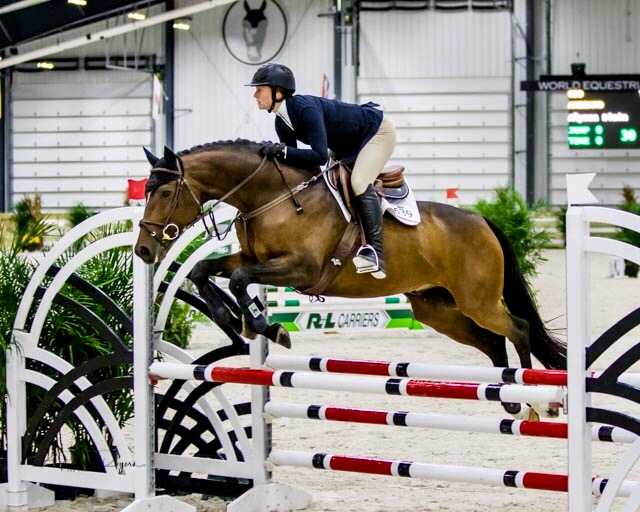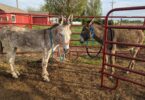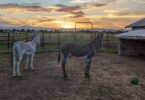Learning how to jump a horse for the first time?
Jumping is an exciting, adrenaline-filled discipline within equestrian sports. Many of us idolize the top show jumpers who make a 1.50-meter course look like a walk in the park. They ride with such precision, ease, and harmony… if only that could be us!
This article gives you helpful showjumping tips beginners can put into practice today.
 So You Want to Jump
So You Want to Jump
Jumping originated with fox hunters and developed into the sport we know today over decades. Jumping is mainly an English discipline, though even Western riders may come across the occasional small jump in upper-level trail classes.
Given the prevalence of jumping in English arenas, it’s easy to assume all English riders school over fences. They don’t, and you don’t need to either–unless you want to.
There are plenty of non-jumping English options like:
- Dressage
- English pleasure
- Endurance
- Polo
- Flat classes (walk, trot, canter)
If jumping is on your wish list, however, then the following tips are for you.
Just remember this: You should learn how to jump at your own pace and not feel pressured to do anything you’re not comfortable with yet.
A good instructor will meet you where you are and tailor lessons to your unique goals, horse, and riding level.
After all, the most important thing about jumping is to have fun!
Jumping Checklist
Before you start to jump make sure you are wearing proper gear and equipment.
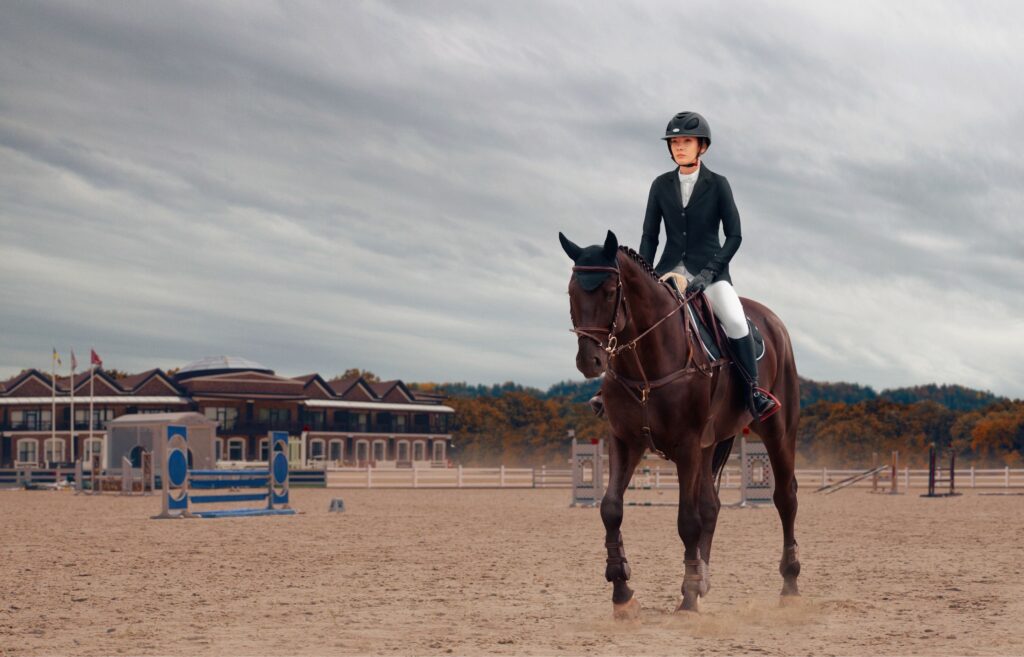
Source: Canva
- Helmet: You need to always wear an approved ASTM helmet.
- Boots: You should wear riding boots with a 1-inch heel.
- Saddle: You should use a close contact or all-purpose saddle, both of which will have a shallower seat and shorter flaps that allow you to shorten your stirrups and get out of the seat over fences. (Dressage saddles have too deep of a seat and restrict your movement.)
Note: It is important to check your tack for wear and tear, as you do not want anything breaking while you’re jumping. Clean your tack often to keep it in good condition and make it last longer!
Stirrups can impact your jumping ability more than you realize. Check out our 10 Best Stirrups for Jumping to learn more.
Beginner Jumping Tips
Find a Horse That Boosts your Confidence
When you start jumping, many instructors will put beginners on a “Steady Eddie,” or an older, more reliable horse. There is a reason for this.
These horses are been-there-done-that schoolmasters who are ready to take you from point A to B (and over any fences in between). They are quiet, can keep a steady rhythm, and can handle rider errors.
It is NOT a smart idea for a rider just learning how to jump to start on a green or hot horse. It compounds problems of inexperienced riders and horses. It will erode confidence in both.
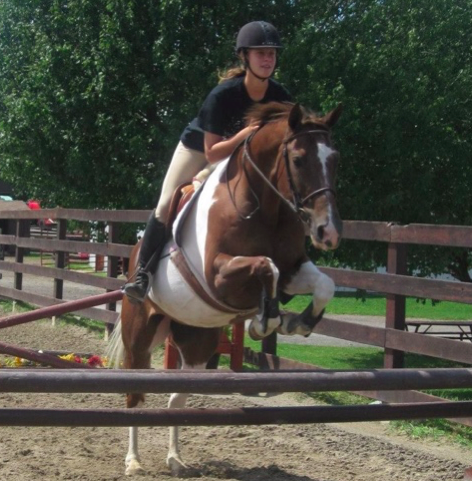
A reliable schoolmaster will give you confidence.
Jumping is fun and it should stay fun during the duration of your learning journey.
Schedule lessons with an instructor who can provide you with a good horse to learn on or give you and your existing horse proper instruction in a safe and controlled environment.
If a suitable instructor isn’t available nearby, make sure you practice jumping your horse in a safe area with someone around to watch.
Take things slowly, and build from the ground up until both you and your horse gain confidence together.
New to the sport? Check out our 26-Page Horse Rookie’s Guide to Jumping.
Flatwork, Flatwork, Flatwork
Before you start over trying jumps of any height, it’s important to have established comfort and skill in your flatwork.
Both you and your horse need to have a solid foundation on the flat (walk, trot, and canter) before jumping.
A great way to think about jumping is flatwork with speed bumps.
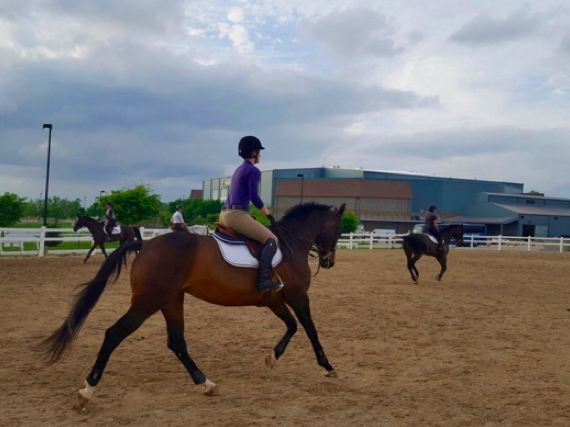
It may seem counterintuitive, but flatwork is the key to jumping.
It’s important to be able to make balanced turns and keep a steady rhythm in the canter, all while keeping a proper rider position with quiet hands and secure lower legs.
Need to improve your flatwork? Practice lots of circles, changes of direction, and serpentines, focussing on your rhythm and balance throughout.
You need your horse to be relaxed and listening to you before you start jumping. Flatwork helps deepen your partnership and establish trust with your horse.
Proper Position = Proper Riding
You need to have a very secure riding position before jumping.
This means having a quiet but strong, steady leg in the full seat and half seat (also known as two-point).
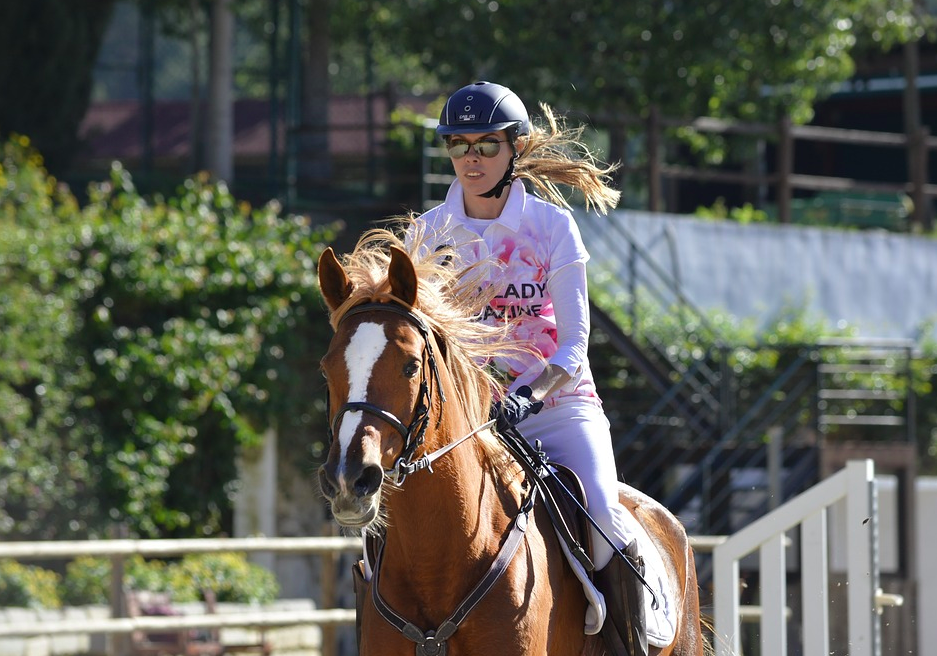
Strengthen your position, and it will pay dividends when you start to jump.
Keep your heels deep, as this will help keep your leg anchored and prevent it from sliding forward or back over the jump.
A good exercise is to get up in your half seat while trotting and cantering and holding the position for a lap then sit back down into a full seat–except keep the same heel depth as you had at the half seat.
Being able to change from half seat to full seat with ease will help you immensely once you start jumping.
According to the USHJA Trainer Certification Manual & Study Guide:
“…correct half seat is where the seat bones are out of the saddle and the rider’s hips are never ahead of the heels. The rider’s weight is down as far as possible into the leg and heel. The motion of the horse dictates how far the rider’s upper body inclines forward and how open or closed the rider’s hip angle should be. The rider remains in control of the horse and does not lose a sense of security.” (USHJA)
Stirrups can impact your jumping ability more than you realize. Check out our 10 Best Stirrups for Jumping to learn more.
Start from the Ground Up
New jumpers should start over ground poles first. A ground pole is a single jump rail that you can lay flat on the ground or you can make it into a cavaletti, which is a ground pole that is raised a few inches off the ground.

Ground poles can teach you a LOT!
Ground poles and cavalettis can be great tools to help train your eyes to see distances (the correct take-off point to a jump) and help you practice counting strides in between obstacles.
Focus on your rhythm–not the distances. If you establish and find your horse’s jumping rhythm, the distances will come so much easier. (Remember, jumping is just speed bumps in your flatwork.)
With ground poles, you can create tons of different exercises, such as courses, grids, circle work, and combinations. The possibilities are endless.
This is also the time to start practicing your half seat over the poles, as if they were jumps, to help you gain more strength and balance.
New to the sport? Check out our 26-Page Horse Rookie’s Guide to Jumping.
The First Jump
Your first horse jump should be a simple cross rail. This is in an “X” formation using two rails crossed in the middle.
Cross rails give you and your horse a center point to help keep you straight before and after the jump.
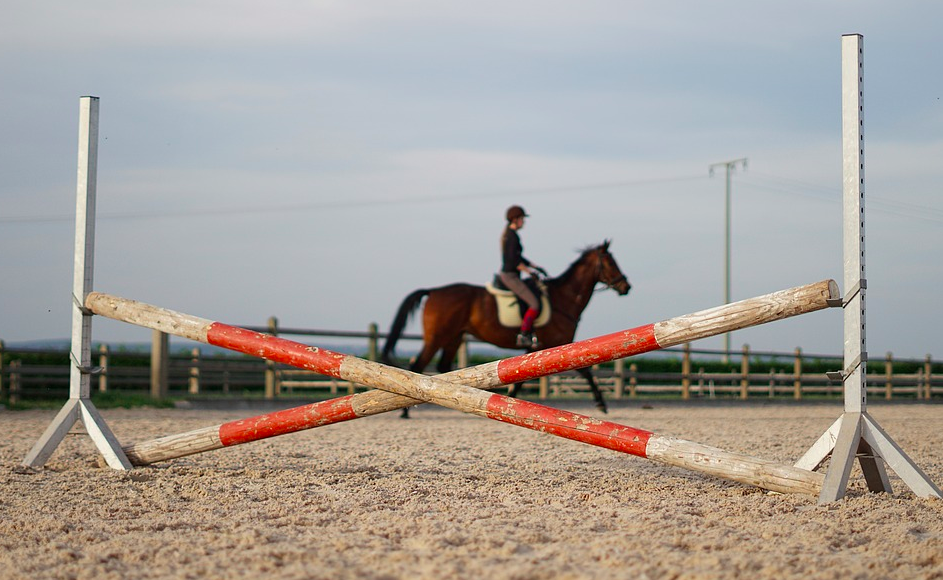
Start small, and get really good at cross rails.
You can trot or canter, but starting at the trot is usually easiest. As you approach the jump, it’s helpful to go up into your half seat a few strides before the jump (at the trot or canter).
As you go over the jump, grab some mane to help your arms learn to follow the natural arc of the horse’s jump as he takes off and lands.
Once you develop more balance and a stronger technique, you can start to vary releases and learn different types.
The biggest goal for your first few jumps is to stay straight, maintain a good rhythm, and follow the motion of the horse with your body and hands.
After you and your horse are comfortable over cross rails, you can start jumping small verticals (a jump with a pole horizontal to the ground).
Continue practicing being straight without the clear center point available with cross rails.
Advance Your Jumping
After you get the hang of the smaller jumps and simple courses, you and your horse can advance to more complicated exercises that develop more advanced skills.

Source: Canva
Before jumping higher (or wider, as with an oxer), make sure your horse is comfortable and able to do so. Not all horses have the proper confirmation, scope, or training to jump 3’6″, but may be perfectly happy jumping 2’6″.
As the rider, don’t feel pressured to jump bigger fences either. Many people are comfortable jumping 3′ and under, which is fine. You can still do many types of exercises at lower heights.
If you are looking to move up through the levels, make sure you have the horse and the foundation to do so safely and confidently.
Remember: It’s always good to go back to the basics to fine tune and strengthen your foundation!
Frequently Asked Questions
Q: What is an oxer?
An oxer is a type of showjumping fence that includes a double set of standards set next to each other. Most oxers are as wide as they are tall. For example, if the rails are set 2′ tall, then the two rails should also be 2′ apart from each other.
Beginners should start with simple cross rails and vertical jumps, then work their way up to oxers slowly. Read about 35 different types of horse jumps.
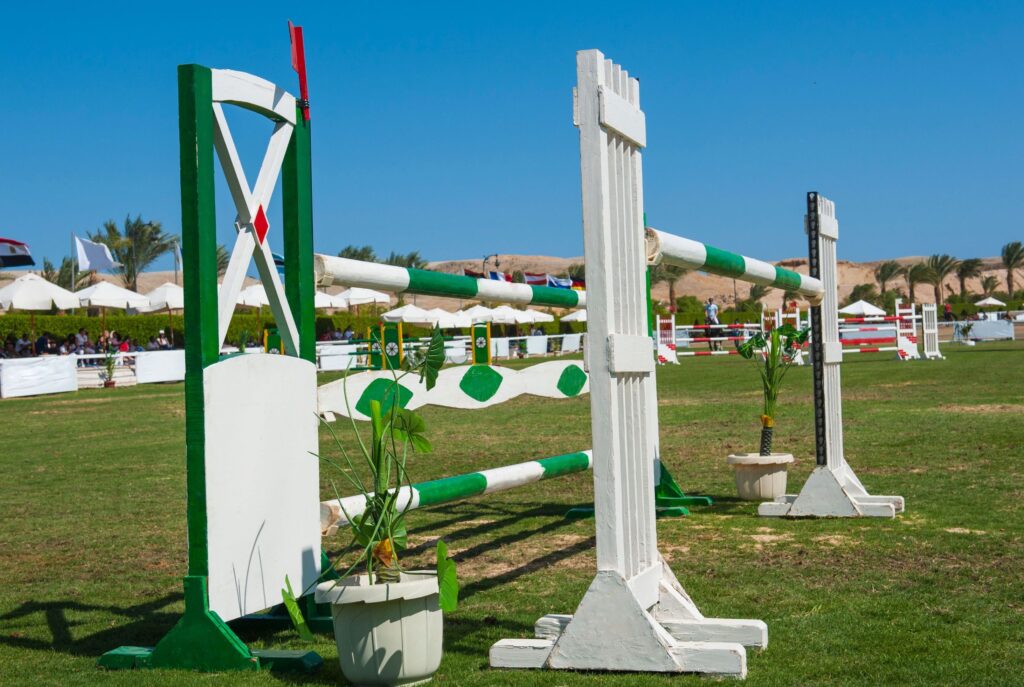
Source: Canva
Q: What are jump cups?
Jump cups are metal or plastic pieces that connect to a vertical standard and hold the rails in place. Standards typically have a series of pre-drilled holes so you can move the jump cups up and down easily to set your ideal rail height.
Q: What horse breeds are good at jumping?
Every horse is unique, so breed alone will not dictate whether a particular horse will enjoy or be gifted at jumping. That said, breeds like the Thoroughbred, Dutch Warmblood, Trakehner, Holsteiner, Oldenburg, and Selle Francais all excel at jumping.
Warmbloods are particularly popular in jump arenas, because of their size, scope, and power. But if you head to smaller shows, don’t be surprised if you see a Quarter Horse or Arabian happily navigating a lower-level course.
Read our article about the 11 best horse breeds for jumping.
Q: What makes a good jumping horse?
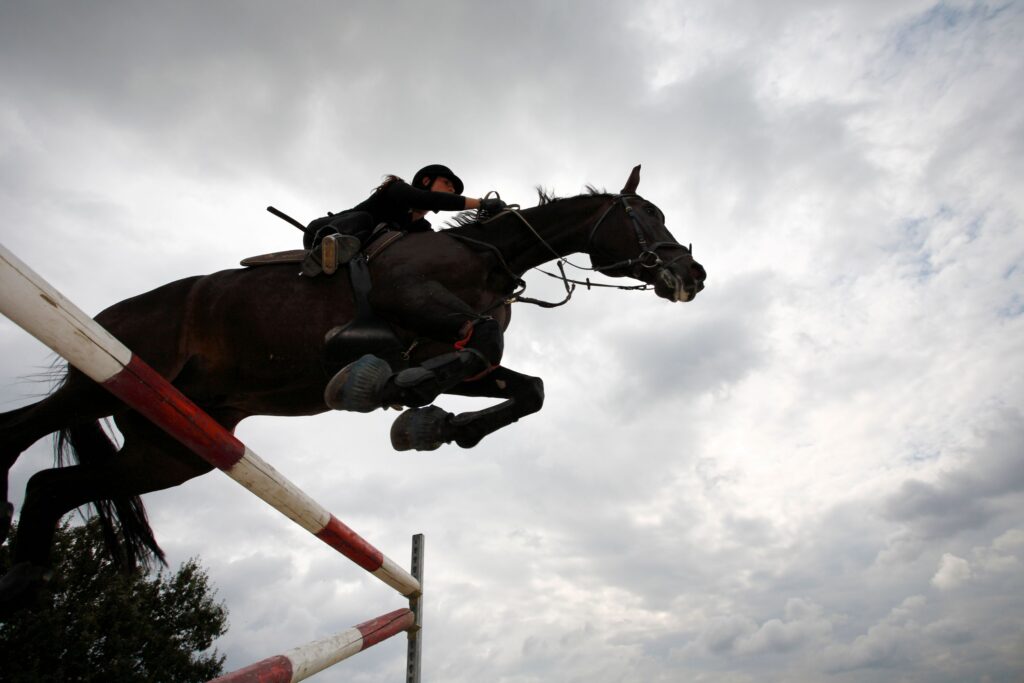
Source: Canva
Here are a few characteristics you’ll see in the best jumping horses:
Jumping Ability: Not all horses are natural-born athletes, but some exhibit above-average ability. This can be apparent from early training, or develop later with more training. Either way, the best jumpers have the ability to navigate complex courses, clear difficult fences, and respond to rider instructions “in the moment.”
Quality Canter: You’ll read a lot about “getting the right canter” for jumping. This typically refers to a canter that is energetic, powered by the hind legs, and uphill in nature. It is much easier for a horse to jump with proper form and power from a quality canter.
Confirmation: The horse’s body should be built to support the activities you’re asking him to perform. If your horse has poor feet, a hollow back, or other physical issues, his ability to jump may be limited.
Adjustable Stride: Grand Prix horses are some of the best examples of what it means to have an adjustable stride. Their riders are able to collect (i.e. make shorter) or extend (i.e. make longer) the canter stride to achieve different distances.
If your horse is unable to condense or lengthen his canter, you’ll end up taking a lot of long jumps (i.e. leaving the ground from too far away) or chipping in (i.e. adding extra strides at the base of the jump).
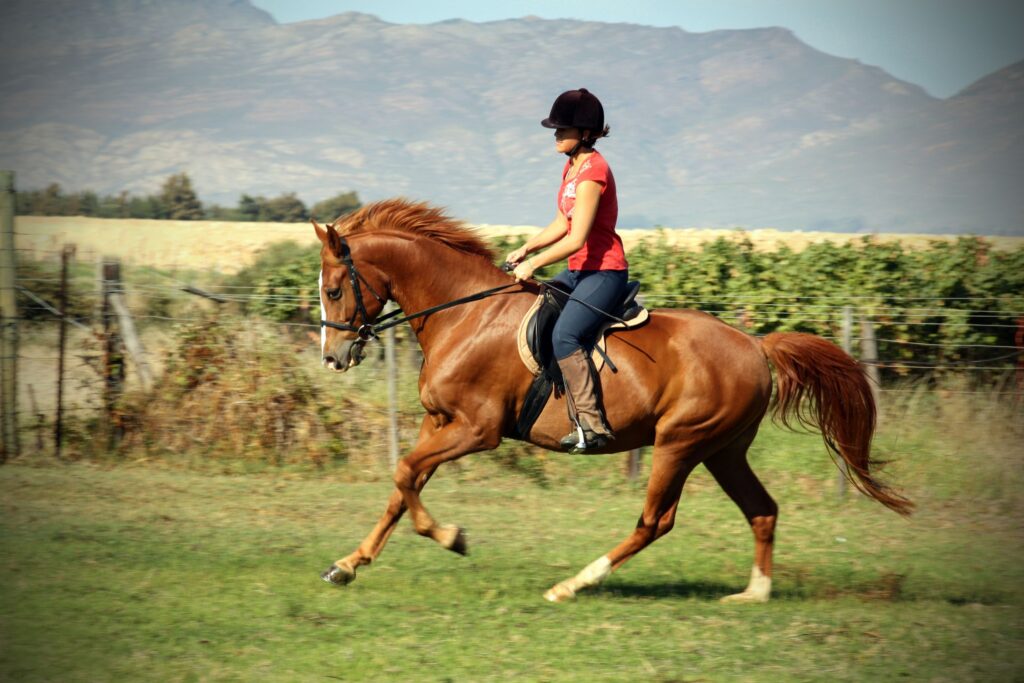
Source: Canva
Q: What is a jump course?
When someone talks about a “jumping course,” they’re referring to a sequence of fences that are to be cleared in a particular order and (often) within a certain amount of time.
Riders are allowed to “walk the course” at competitions by foot before taking the jumping class begins. It allows them to take a close look at each fence, map out strategies, plan distances, and make note of any area that might cause their horses trouble.
New to the sport? Check out our 26-Page Horse Rookie’s Guide to Jumping.
Q: What is a trot pole?
In equestrian terms, trot poles are the same as “ground poles.” These are jumping rails that lie on the ground vs. being raised off the ground with standards.
Trot poles are spaced at regular intervals and used in the training process to teach horses how to find their distances, and move well over poles. They can also be placed in between or in front of a normal fence and can help a horse that rushes the approach in a trot (rider should posting trot) instead of breaking into a canter.
Q: Can you teach an older horse to jump?
Despite the saying, you can teach an old horse new tricks. Just don’t expect your older horse to be going to a Grand Prix anytime soon.
Start slow, working your horse at a trot over ground poles. This helps build muscle and gets him used to picking up his feet.
Then, lunge him over some low cross rails. Start with the trot and work up to the canter. When you’re ready to try a cross rail under saddle, line a few ground poles in front of it first. This will help your horse get ready for the higher lift. Trot in at a steady pace and be prepared for a bit of a bump over the cross rail.
Q: What are the five phases of showjumping?
There are five phases involved with clearing any fence, regardless of height. These are the approach, the takeoff, the flight, the landing, and then the recovery.
Focusing on these phases can stop you from getting bogged down by countering strides, improve your jumping ability, and give your horse the best chance of success.
Q: Do horses jump for fun?
Some horses love to jump for fun! Others, not so much. In the wild, horses prefer to go around objects rather than over them. And when they do choose to go over, many walk or trot rather than jump.
Humans have been breeding sport and jumping horses for centuries now, so some horses seem to have a larger drive to jump. However, as this study about jumping motivation shows, the higher the jump, the less motivated the horse was to go over it.
Jumping isn’t a natural pastime for horses, so if your steed doesn’t like it, consider giving him a different job.
Staying safe is key when you’re jumping. Read our Hit Air Equestrian Vest Review to learn how technology advancements can keep you safe.
P.S. Enjoy this article? Trot on over to:
- 25 Tips to Take Your
Show Jumping from Average to Awesome - Breaking Down Horse
Show Jumping Heights (Rookie Guide) - Jump Jargon: A Simple Guide to Horse Jumping Terms
- 10 Best Stirrups for Jumping Clear (And Staying Safe)
- 100+ Things to Pack for a Jumping Horse Show (Checklist)
- 4-Star Favorites: The 4 Best Cross-Country Stirrups
- Horse Riding for Older Adults: Why It’s Never Too Late
- Shelby Dennis: Best Horse Riding Advice & Biggest Rookie Mistakes
- Compositi Stirrups Review: I’ve Never Jumped Better
References:
- USHJA Trainer Certification Manual & Study Guide

